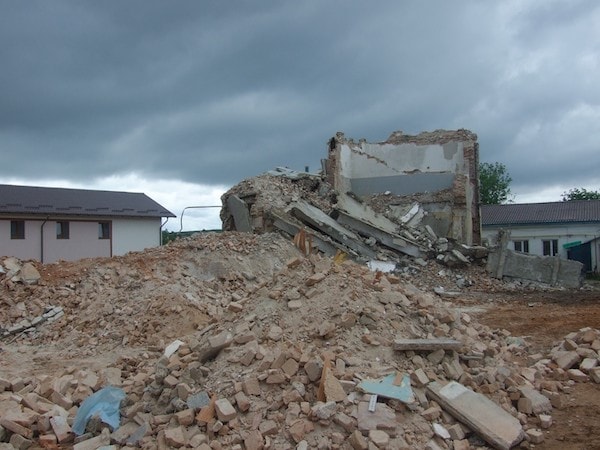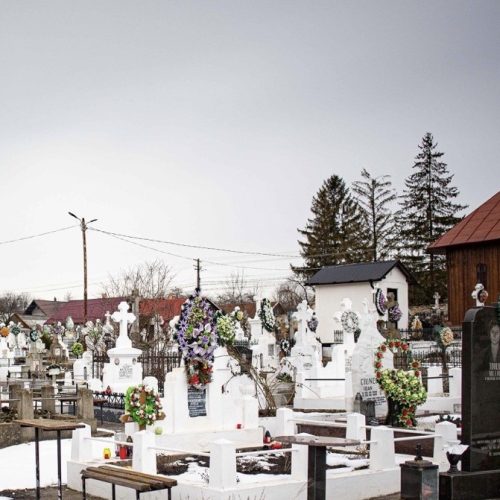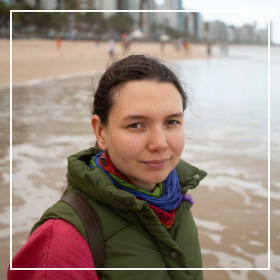Upon entering the Orthodox Christian cemetery in Siret, a town on the Romanian-Ukrainian border, we were met with neatly kept marvel gravestones, occasionally adorned with plastic flowers and recently-lit candles.
After passing numerous graves, at the very end of the small road near the church, we encountered a very different site: the section of the cemetery designated for people with disabilities who had lived at a nearby large children’s institution. A criminal investigation had massively transformed the spatial organization of this cemetery between 2018 and my fieldwork in February 2020.
In 2018, a trial had been initiated by the Institute for the Investigation of the Crimes of Communism and the Memory of the Romanian Exile (hereafter IICCMER), a government agency tasked with researching crimes committed during the state socialist period and initiating criminal complaints. Deaths of children with disabilities from the hospital, up until then invisible, were rendered visible through the creation of a site of negative heritage. The limits of these practices and critical reflection of past necropolitical violence against people with disabilities open-up the possibility for a more hopeful future. In this discussion, I center disability-related violence as opposed to views that instead center communist-era violence as the main locus of recognition and change. This is significant, since whereas communist-era violence can be assumed to have ended with the regime, disability-related violence continues into present times.
The hospital was opened in Siret in the mid-1950s, and by the early 1980s, it housed more than one thousand children. Like the other three care institutions against which investigations were opened by the IICCMER, the hospital was dedicated to children with disabilities, most of which bore the pseudo-scientific label of ‘unrecoverable’ (‘irecuperabil’). The hospital in Siret was gradually downsized since the 1980s. Around Christmas 1990 it came to some infamy after international volunteers exposed the living conditions in the hospital as part of the humanitarian BBC reality TV show “Challenge Anneka” in the episode “The Romanian Orphanage”. Several deinstitutionalization projects followed and the hospital was closed in 2001.
Whereas communist-era violence can be assumed to have ended with the regime, disability-related violence continues into present times.
In recent years, accounts of hundreds of preventable deaths that had occurred in the hospital during in the 1980s have come to light through a criminal complaint initiated by the IICCMER. Most of these deaths were caused by pneumonia during the winter months of the early 1980s, a time of economic deprivation everywhere in Romania. As pneumonia was a preventable and treatable illness at the time, the complaint opens up the space of reflecting on the inhuman living conditions in the hospital (see Safta-Zecheria 2020). The complaint has also transformed the local memory landscape and opened up a space for reversing the invisibility of children’s deaths in the institution.
The hospital’s main building was demolished in 2015 to symbolically mark the end of the institution. At the time, discussions regarding the afterlife of the building blossomed on a local level. In the end, demolition was preferred over establishing a museum of institutionalization in the building. During my long-term ethnographic fieldwork in Siret in 2015, I learned that one of the reasons behind this decision was that the building itself harbored too many traumatic memories for the people who grew up there and still lived in town. Local decision-makers thus favored erasing the memory of the site over transforming it into a Mahnmal.
In the end, demolition was preferred over institutionalization.

The demolition of the hospital’s main building did not block the re-emergence of the question of where and how the violence that had taken place at the hospital could adequately be remembered. The question re-emerged in relation to the Orthodox cemetery.
The differentiated spatial organization of the cemetery shows that people who died at the hospital are still marginalized in death, as they were segregated and ignored in life. The section of the cemetery where the previous residents of the hospital were buried, as the deathscape of people who had grown up at the hospital, is markedly different from that of other locals. As the photograph taken in February 2020 shows, there are no marble gravestones and barely any neatly-kept graves in this section. The panoramic image creates the impression of a mass grave, as very few graves appear individually marked. A local press report revealed that not even the priest who has served in the chapel since 1982 could tell how many children lay buried in the plot – let alone identify them. The haphazard burial practices and the anonymity of the graves continue to render the deaths of children from the institution invisible.

At the entrance, one is greeted with a monument adorned with a marvel statue and plastic flowers. It effectively hides the section of the cemetery from the outside view. The statue shows two sleeping angels that are joined by a heart and a cross and is captioned May God rest them in the kingdom of heavens. The monument to unnamed children reminds the viewer of graves to unknown soldiers and points to what Jeremy Walton (2020) has called the limits of knowledge in relation to the history of violence: neither the exact number nor the identities of the children buried there can be known today.
Disability-related violence in institutions must be addressed beyond blanket condemnations of ‘Communism’.
Locals say the monument erected in 2018 materialized through the efforts of a former nurse who had worked at the hospital and was strongly involved in the efforts to integrate the children into the community. The nurse is rumored to have erected the monument with support from international volunteers who had started coming in the 1990s. Local press reports state that it was erected as a consequence of the media attention to deaths of the children in the wake of the launching of the criminal complaint by the IICCMER. Alongside the erection of the monument, the cemetery was also cleaned of the growing weeds that were hiding the few existing crosses and marked graves, and trees were planted. Yet, this monument at the very entrance still stands in stark contrast to the remainder of the segregated section that, as can be seen in the panoramic image, remains desolate.

This shift in the spatial organization of the cemetery parallels a change in memory practices. On the one hand, religious practices underwent a renaissance in the 1990s, but this alone cannot account for the transformations in the landscape of the cemetery. This transformation mirrors the repositioning of the social category of people with disabilities in the post-socialist memory landscape, akin to the repositioning of other social categories described by Katherine Verdery in her book The Political Lives of Dead Bodies (1999, 20). That deaths of children with disabilities are remembered retrospectively and not at the time of the burial points. This repositioning is an act of creating negative heritage. Negative heritage entails the creation of “a conflictual site that becomes the repository of negative memory in the collective imaginary” (Meskell, 2002, 558). In this case, the site of negative heritage is constructed in relation to the condemnation of the state-socialist past and not primarily to enable acts of collective mourning.
Graves that have once been unmarked acquire visibility as the section is weeded. While the section of the cemetery now shows the transformation of a previously actively erased space of burial into a space of negative heritage, the fragmented and sporadic individual acts of mourning are also rendered more visible. The weeding of the overgrown cemetery is an act of reinscribing the previously ignored and unattended space. Individual metal crosses that had marked graves have now come to light, foregrounding inscriptions such as that in this image: Here rests God’s servant T.E., 13 years old. We will never forget you. A tree planted on another grave has also become more visible, showing how time has amplified the effort at remembering embedded in marking the resting place of someone with the planting of a tree. Moreover, close to the path are the graves of people with disabilities that have grown up at the hospital and have died in the years since its closure. The grave of a young man whom I had met in 2015 when he was suffering from a terminal illness is now neatly kept, resembling the graves of other locals buried in the cemetery. Many of my interlocutors in 2020 had been deeply saddened by his death and reminisced about the funeral and their shared memories of his life.

Apart from setting in motion a change in the space of the cemetery, the investigations lead by the IICCMER uncovered that many of those that have been buried in the cemetery had likely died of preventable causes. Although the IICCMER investigation only focused on the 1980s, continuities with previous and even later decades were strongly present in conversations I had with survivors of the hospital. This drives home that systematic forms of erasure of the lives and memories of people with disabilities need to be challenged: disability-related violence in institutions must be addressed beyond blanket condemnations of ‘Communism’. Associating the violence against children with disabilities only with the communist era as an already completed historical epoch obscures ongoing violence against people with disabilities. This is the case since the violence in institutions is publicly discussed either through the lens of ‘condemning Communism’ or as an ongoing yet ahistorical phenomenon. In this debate, I argue that the meaning structures that underpin the necropolitics towards children with disabilities risk remaining unchallenged, while the dead bodies of the children in the cemetery are used to legitimize the present day political order as a morally superior one.
The deaths of the people buried here are the deadly consequences of a disability-related politics that actively prevented the formation of what Elizabeth Povinelli (2011) calls an ethical impulse associated with the eventfulness of the death of certain categories of people. Pseudo-scientific labels such as ‘unrecoverable’ worked to neutralize hope for individual ‘progress’.
Accounts of carers from the institution in Siret whom I have spoken to and an example from another similar institution show that the deaths of children were normalized by being explained by professionals as caused by disabilities and not by the living conditions and practices in institutions. Thus, preventable deaths that can be attributed to the living conditions in the institution, like those caused by pneumonia and in other institutions also malnutrition, appeared as unpreventable likely outcomes of ‘unrecoverability’, a dynamic which impeded the formation of a public ethical impulse that would sustain action towards safeguarding life. Thus, normalization of the occurrence of these deaths lead them to become uneventful and publicly invisible.
Other residents who did not go to school continued to receive ‘food from the bucket’.
These deaths suggest that some of the children at the hospital had come to inhabit what Mbembe (2003) calls the necropolitical position of the living dead. Survivors of the hospital told of how when they started going to school, they also began to receive three course meals and were encouraged to use cutlery. They remembered also that other residents who did not go to school continued to receive ‘food from the bucket’. I came to understand how serving food was one of the processes through which biopolitics operated in the institution. Those receiving ‘food from the bucket’ were likely deprived of other life furthering resources as well, pointing to a necropolitical positionality. This positionality is also maintained in the exclusion from practices of remembering those who have died.

Yet, this deathscape is fragmented. As is visible in the space of the cemetery, some individual graves were marked as places of remembering and memory – some received signification and were individualized in death. During the lifespan of the hospital, children with disabilities were brought to the hospital from various places in the entire country, thus being separated from close kin by considerable distances, which effected how visible acts of mourning could be made in the cemetery. After the hospital was closed, the community of people who had grown up at the hospital and other locals came to publicly mourn those members who died more recently. This process is visible in more neatly kept graves, in the memories of funerals and the pictures and stories of the deceased that I was told during my fieldwork.
Most people with disabilities buried in the cemetery were subject to a two-fold violence. First, they were victims of brutal living conditions that contributed to their deaths. Second, their deaths were rendered meaningless, anonymous and invisible. A negative heritage site has emerged that can contribute to the normalization of people with disabilities right to live a full and dignified life. Yet, it should not merely be used to delegitimize the state-socialist past. It should open up a space for critical examination of the violence to which children with disabilities were exposed and how this violence was rendered invisible.
References
Mbembe, Achille (2003) Necropolitics, Public Culture 15(1):11-40
Meskell, L. (2002). Negative heritage and past mastering in archaeology. Anthropological quarterly, 75(3), 557-574.
Povinelli, Elizabeth (2011). Economies of abandonment: Social belonging and endurance in late liberalism. Duke University Press.
Safta-Zecheria, L. (2020). Divided collective memory and the judicialization of (past) necropolitical practices around institutions for children with disabilities in Romania. New Europe College Stefan Odobleja Program Yearbook, (2019+ 20), 167-206. https://www.ceeol.com/search/article-detail?id=1008120
Verdery, Katherine (1999). The political lives of dead bodies: Reburial and postsocialist change. Columbia University Press.
Walton, J. (2020) Already dead? Of tombstones, empire and photography, in Carabelli, G., Jovanović, M., Kirbis, A., & Walton, J. F. (eds.). (2020). Sharpening the Haze: Visual Essays on Imperial History and Memory. Ubiquity Press.
The present blog post is based on research conducted as part of my fellowship at the New Europe College Bucharest 2019/2020 and supported by a grant of the Romanian National Authority for Scientific Research and Innovation, CNCS/CCCDI – UEFISCDI, project number PN-III-P1-1.1-BSO-2016-003, within PNCDI III. I especially want to thank Jeremy Walton, Annika Kirbis and Serawit B. Debele, Felix Girke for feedback on previous versions of the ideas put forth here and Mugur Ciumăgeanu for the wonderful images.





